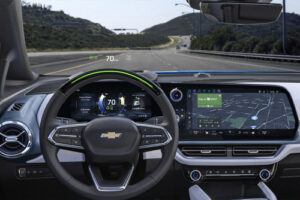
GM works to build ADAS confidence to help market grow
By onAnnouncements | Technology
General Motors (GM) has launched an educational campaign to boost consumer confidence in advanced driver assistance systems (ADAS).
The automaker said it rolled out its “Hands Free, Eyes on” campaign as part of a larger effort to raise awareness of its Super Cruise hands-free driving system and clear up confusion surrounding ADAS.
Part of that involves explaining the difference between ADAS, which requires drivers to remain focused on the road at all times, versus fully autonomous driving, the automaker said.
“We know that to help achieve our vision of zero crashes, we must increase the adoption of ADAS and proactively highlight the benefits they offer,” said Scott Miller, GM vice president of software defined vehicle and operating system.
“To increase usage, we must help drivers understand how currently available technologies, like Super Cruise, work and the responsibility drivers have when using ADAS features. We want customers to be assured of what we are doing to safely deploy these technologies.”
GM’s said its ADAS program’s core tenets include:
-
- “A commitment to testing and validation;
- “Integrating a comprehensive set of sensor technologies;
- “Ensuring technologies have driver attention systems;
- “Keeping our maps updated by monitoring roads and working with the public sector; and
- “Educating consumers and other stakeholders.”
Its efforts building ADAS consumer confidence were announced shortly after the release of a McKinsey survey that showed between 25 to 30% of drivers with basic ADAS features, such as cruise control or parking assistance, either never or seldomly use them.
“Their prime reasons for not using ADAS range from the joy of driving to not knowing when to use them to a fear of technology failure,” the report said.
However, the study also indicated that could soon change, indicating that just five percent of electric vehicle (EV) buyers say they don’t want any ADAS features in their cars. Within the premium segment, that figure fell to less than one percent.
“On average, EV owners are more likely than other car buyers to consider purchasing ADAS features—two times more likely than traditional internal-combustion-engine (ICE) car buyers. Premium-brand buyers also show a higher interest in buying ADAS,” McKinsey said.
It later added: “ADAS features play a role in the purchase decision, especially among EV buyers and the premium-brand segment: 42 percent of EV buyers and 38 percent of premium-brand car buyers say they would be highly likely to switch brands for better ADAS features. Among traditional combustion engine car buyers, only 22 percent say they are highly likely to do so.”
McKinsey added that autonomous driving (AD) technologies could play an even more important role in user experience going forward, saying throughout core AD use cases, it sees a market value pool of up to $400 billion within the next decade.
However, the market has yet to form a consensus on the matter with S&P Global Mobility’s recently released Global Mobility spring survey finding that while those shopping for a new car want the vehicle to include ADAS, they are less enthusiastic about semi-autonomous features.
Trust and familiarity remain barriers preventing drivers from embracing self-driving technologies, S&P Global Mobility’s newly released Global Mobility spring survey found.
“There is a lack of exposure to the mainstream consumer,” said Yanina Mills, senior technical research analyst at S&P Global Mobility. “They don’t exactly know how it is going to work. There is confusion. They are asking, ‘Is it self-driving, or is it just going to help me a bit and I still have to focus?’”
Images
Featured image: Super Cruise in operation on a 2023 Chevrolet Tahoe. (Provided by Chevrolet)
